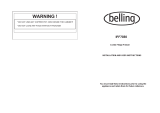
1. Baked, chilled cooked food, dairy
products, cans.
2. Wine bottles.
3. Meat, sausages, cold cuts.
4. Fresh fruit and vegetables.
5. Frozen food and freezing of fresh food.
6. Frozen food.
7. Small bottles, cans, tubes.
8. Eggs.
9. Tall, large bottles, beverages.
SUGGESTED ARRANGEMENT OF
FOOD IN THE FRIDGE/FREEZER
Arrangement examples (see diagram)
The following guidelines and recommendations are
suggested to obtain the best results and storage hygiene.
1. The fridge compartment is for the short term storage of
fresh food and drinks.
2. The freezer compartment is rated and suitable for the freezing and storage of
pre- frozen food. The recommendation for storage as stated on the food packaging
should be observed at all times.
3. Cooked dishes must be stored in airtight covered containers.
4. Fresh wrapped produce can be placed on the shelf. Fresh fruit and vegetables should
be cleaned and stored in the crisper bins.
5. Bottles can be placed in the door section.
6. To store raw meat, wrap in polythene bags and place on the lowest shelf. Do not allow
to come into contact with cooked food to avoid contamination. For safety, only store raw
meat for two to three days.
7.
Keep the food packed wrapped or covered. Allow hot food and beverages to cool before
placing t hem in the fridge. Do not store explosive substances. High proof alcohol must be
stored upright in sealed containers. Left over canned food should not be stored in the can.
8. Fizzy drinks should not be frozen and products such as flavoured water ices should not
be consumed too cold.
9. Some fruit and vegetables suffer damage if kept at temperatures near 0°C. Therefore
wrap pineapples, melons, cucumbers, tomatoes and similar produce in polythene bags.
10. Place chilled cooked food and similar food near the rear of the fridge inner liner where
the cold wall is located.
11. Shelves, racks, crisper bins, drawers, flaps, bottle grippers are all removable.
12. Do not leave frozen food at room temperature to thaw; the best way to defrost food is
to put it in the fridge to thaw slowly. Make sure you avoid defrosting food or food juices
drip
onto other food.
13. For hygiene reasons, always wrap food using a suitable packaging material before
storing in your appliance to avoid contact with the appliance surface.
14. Maximum frozen food storage volume can be achieved without using the upper shelf
cover located in the freezer. Energy consumption of your appliance is declared while the
freezer compartment is fully loaded without the use of upper shelf cover.
1
2
3
4
5
6
6
7
7
8
9
7
1
HarvestFresh
Fruits and vegetables stored in crispers illuminated with the HarvestFresh technology
preserve their vitamin content (vitamin A and C) for a longer time thanks to the blue,
green, red lights and dark cycles, which simulate a day cycle.
If you open the door of the refrigerator during the dark period of the HarvestFresh
technology, the refrigerator will automatically detect this and enable the blue, green or
red light to illuminate the crisper for your convenience. After you have closed the door of
the refrigerator, the dark period will continue, representing the night time in a day cycle.





















